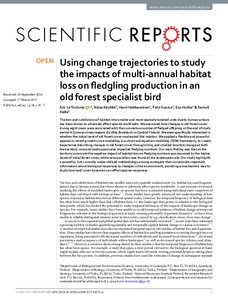Using change trajectories to study the impacts of multi-annual habitat loss on fledgling production in an old forest specialist bird
Suorsa P; Kayhko N; Hakkarainen H; Le Tortorec E; Helle S; Huhta E
Using change trajectories to study the impacts of multi-annual habitat loss on fledgling production in an old forest specialist bird
Suorsa P
Kayhko N
Hakkarainen H
Le Tortorec E
Helle S
Huhta E
NATURE PUBLISHING GROUP
Julkaisun pysyvä osoite on:
https://urn.fi/URN:NBN:fi-fe2021042717014
https://urn.fi/URN:NBN:fi-fe2021042717014
Tiivistelmä
The loss and subdivision of habitat into smaller and more spatially isolated units due to human actions has been shown to adversely affect species worldwide. We examined how changes in old forest cover during eight years were associated with the cumulative number of fledged offspring at the end of study period in Eurasian treecreepers (Certhia familiaris) in Central Finland. We were specifically interested in whether the initial level of old forest cover moderated this relation. We applied a flexible and powerful approach, latent growth curve modelling in a structural equation modeling (SEM) framework, to create trajectories describing changes in old forest cover through time, and studied how this change at both the territory core and landscape scales impacted fledging numbers. Our main finding was that at the territory core scale the negative impact of habitat loss on fledging numbers was lessened by the higher levels of initial forest cover, while no association was found at the landscape scale. Our study highlights a powerful, but currently under-utilised methodology among ecologists that can provide important information about biological responses to changes in the environment, providing a mechanistic way to study how land cover dynamics can affect species responses.
Kokoelmat
- Rinnakkaistallenteet [19207]
